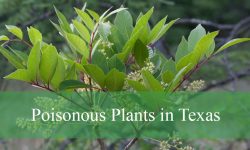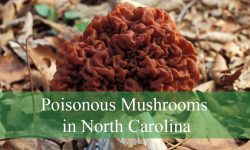Flowers that cover the ground create a stunning tapestry of colors and textures, transforming ordinary landscapes into vibrant works of art. These ground-covering plants not only add aesthetic value but also provide practical benefits such as soil erosion control and weed suppression.
From the delicate blooms of creeping thyme to the bold hues of creeping phlox, each species brings its own unique charm, ensuring that gardens and open spaces remain lively and captivating throughout the seasons.
These plants are typically easy to grow, require minimal maintenance, and can adapt well to various environmental conditions. Utilizing ground cover plants is an effective and sustainable method for maintaining and protecting the environment.
Different Types of Flowers That Cover the Ground
Creeping Phlox

A small shrub with vibrant springtime flowers that often covers retaining walls or hillsides is called creeping phlox. It’s still a springtime superstar, even though it’s less obvious in other seasons. The least amount of maintenance is to water it during dry spells and clip it back after it blooms.
When given the correct circumstances, it can spread, but it is simple to manage by removing undesired shoots. It needs full sun and rich, well-drained soil, and it can tolerate clay. It grows best in USDA zones 3 through 9.
Angelina Sedum
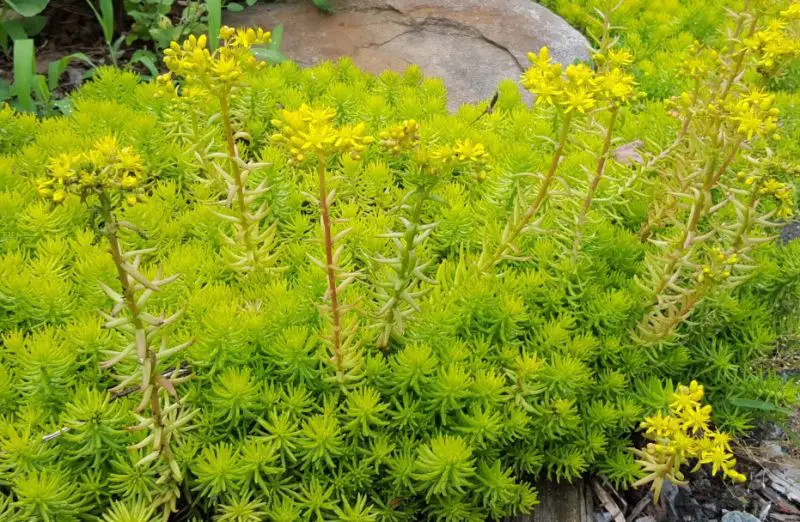
Similar to yellow alyssum, angelina sedum is a “Goldilocks” type of ground cover. Its golden foliage spreads efficiently, yet it doesn’t get in the way. It spreads swiftly and easily through roots, producing succulent leaves all over an area. Occasionally trim back the stems to maintain control; if they fall off naturally, they can self-root.
This plant grows best in USDA zones 5 through 8, favoring well-drained, neutral soil and full sun over partial shade.
Nepeta
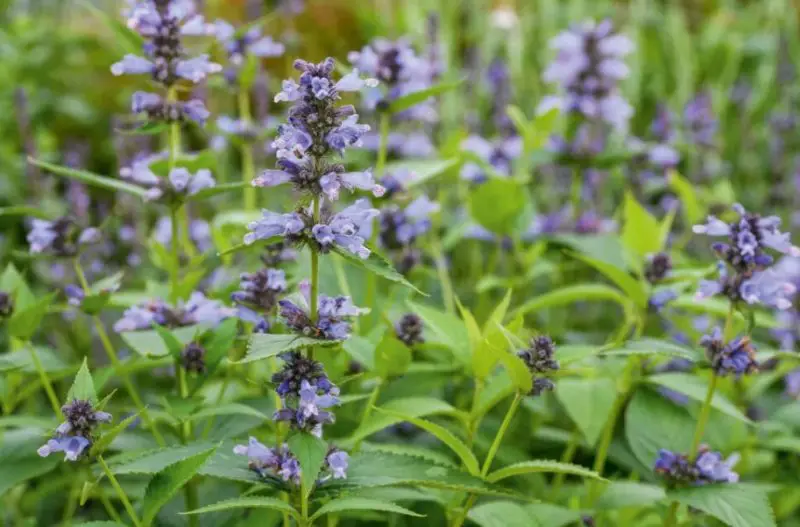
Nepeta × faassenii is a hybrid perennial catmint that goes by the names nepeta, nepeta catmint, and Faassen’s catmint. It is a sterile plant that does not yield viable seeds since it is a hybrid of Nepata racemosa and Nepetella. There are over 250 species in the genus Nepeta; most are annuals or perennials that make good ground covers; however, others are very invasive.
Nepeta x faassenii makes a great ground cover, especially when it comes to weed management. With its 36-inch growth and continuous purple flowering throughout the summer, the ‘Six Hills Giant’ cultivar is perfect for wide spaces. It grows best in USDA zones 3 through 8, where it requires dry to medium, well-drained soil, full sun to partial shade.
Creeping Thyme
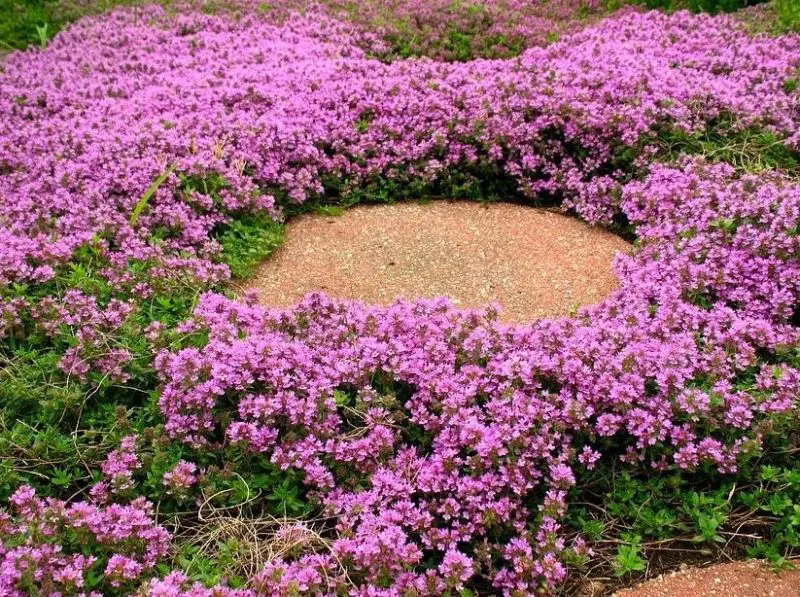
Also referred to as the mother of thyme or wild thyme, creeping thyme is a low-maintenance ground cover that is perfect for filling in the spaces between stepping stones in a garden. It spreads over time, driving out weeds and requiring less care as it grows only 3 inches tall.
In addition to the fragrant leaves, the deep pink blooms that bloom from June to July draw bees and other pollinators. It grows best in USDA zones 4 through 8, full sun, low fertility, well-drained, alkaline soil, and is not used in cooking.
Wall Germander
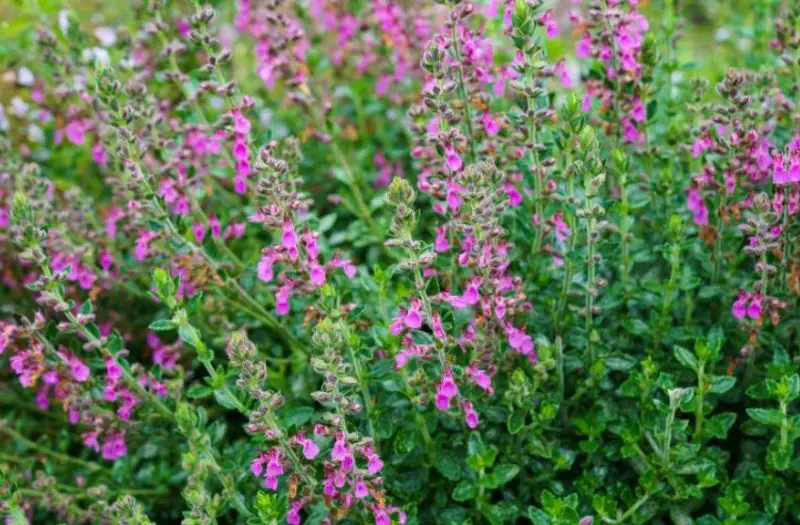
Teucrium chamaedrys, commonly known as wall germander, is a unique evergreen with woody stems that is frequently utilized as a ground cover, low hedge, or in knot gardens. This sun-loving plant produces lavender to pink flowers in July and reaches a height of about 12 inches with a spread of 24 inches.
Pinching it back frequently keeps it bushy and “shrubby.” It needs full sun, neutral to alkaline, well-drained soil, and it can withstand poor soil conditions. It grows best in USDA zones 5 through 9.
Basket-of-Gold
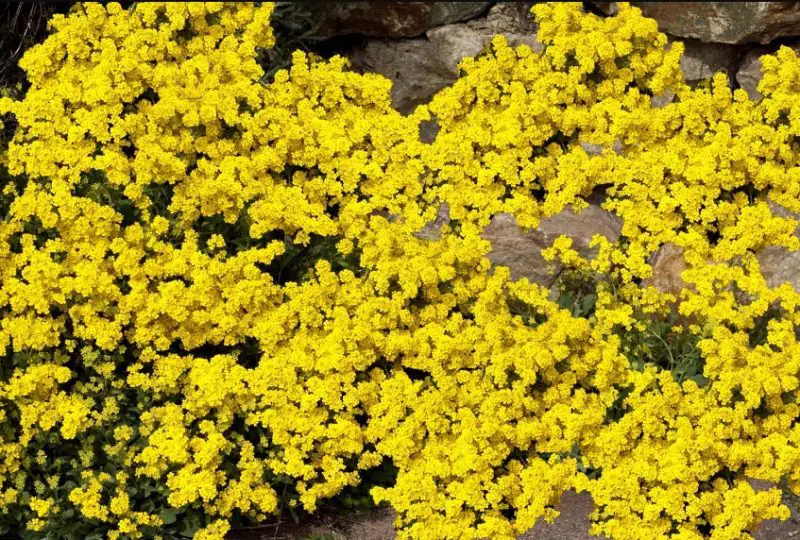
Aurinia saxatilis, often known as Basket-of-Gold, is a low-maintenance, drought-tolerant ground cover that is perfect for rock gardens. Once planted, it merely needs to be watered occasionally in the summer. When it starts to get too scraggly or after it flowers, clipping is the main maintenance required. It is also referred to as a yellow alyssum and has clusters of vivid yellow flowers.
To prevent a mistake with sweet alyssum, a distinct species, when making a purchase, make sure you are buying Aurinia saxatilis, also known as yellow alyssum. It grows best in full sun and well-drained soil in USDA zones 4 through 7.
Amethyst in Snow
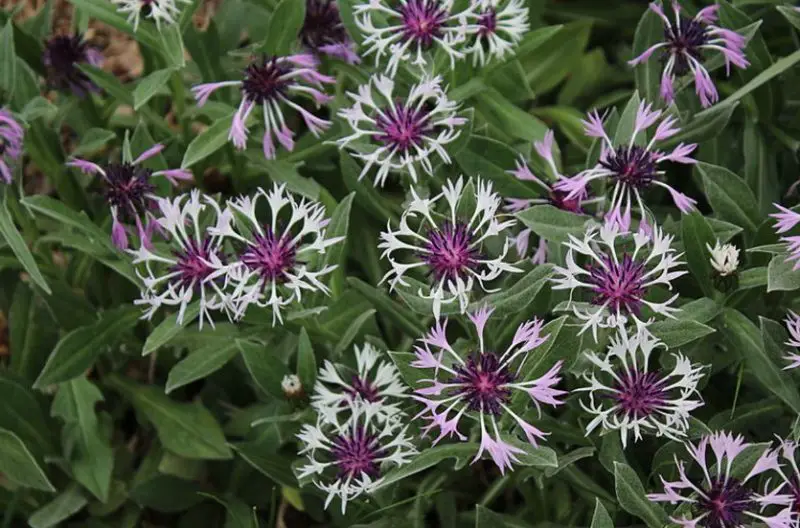
You might consider Centaurea montana ‘Amethyst in Snow’ to be an upright perennial with showy flowers when you purchase it. But given the correct circumstances, it blossoms and spreads well as a ground cover. It is low-maintenance and easy to take care of as a ground cover. It expands swiftly in optimum sunny conditions, but wayward shoots may be pulled out and regulated simply.
Take into consideration C. montana ‘Amethyst Dream’ as a less assertive choice. It grows best in USDA zones 3 through 7, in well-drained, low-fertility soil that receives full sun to partial shade.
Creeping Juniper
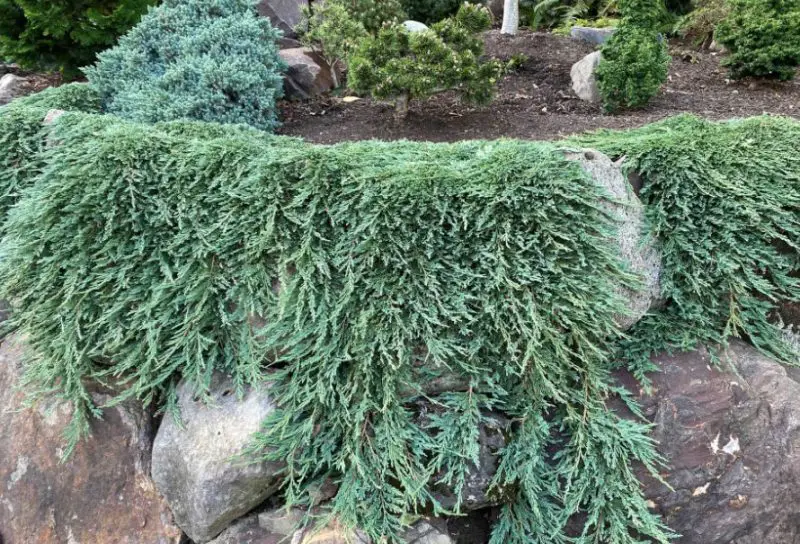
Juniperus horizontalis, sometimes known as creeping juniper, is a spreading, evergreen shrub with a maximum height of 18 inches and a maximum spread of 8 feet. Large expanses of challenging terrain, like hills where grass won’t grow, are perfect for covering with their assortment of cultivars, which includes ‘Blue Rug.’
On a grassy slope, plant after removing the grass, laying landscape cloth, making planting holes, and mulching the area. In full sun and medium to dry, sandy, well-drained soil, this shrub grows well in USDA zones 3 through 9.
Rock Cotoneaster
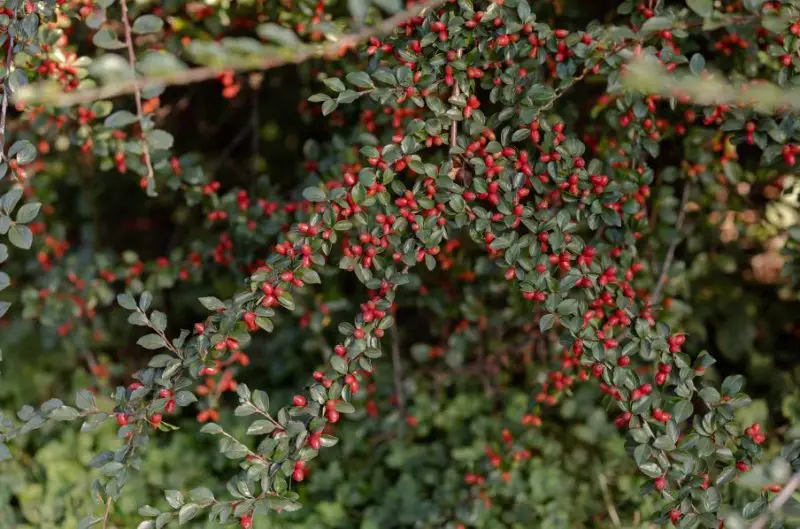
Rock cotoneaster (Cotoneaster horizontalis) is a deciduous shrub prized for its vibrant red berries, which add ornamental value to gardens. It also displays attractive fall foliage. Known for its horizontal growth habit, this shrub spreads where its branches touch the ground, forming new plants. It thrives in USDA zones 3 to 9, preferring full sun to part shade.
While it enjoys full sun, it benefits from afternoon shade in hotter climates and requires moist, well-drained, loamy soil. Adequate watering, especially during establishment, promotes healthy growth.
Bunchberry

The shade-loving deciduous shrub bunchberry (Cornus canadensis), which is native to northern North America, thrives in wooded environments and is a great choice for shady woodland gardens. This pretty relative of dogwood trees reaches a maximum height of around 9 inches and blooms with exquisite white flowers from May to July.
It is a hardy option for naturalistic landscapes because of its outstanding resistance to deer and rabbit damage. Bunchberry grows well in USDA zones 2 through 6, with a preference for partial shade and rich, wet, well-drained, acidic soil.
Spotted Deadnettle
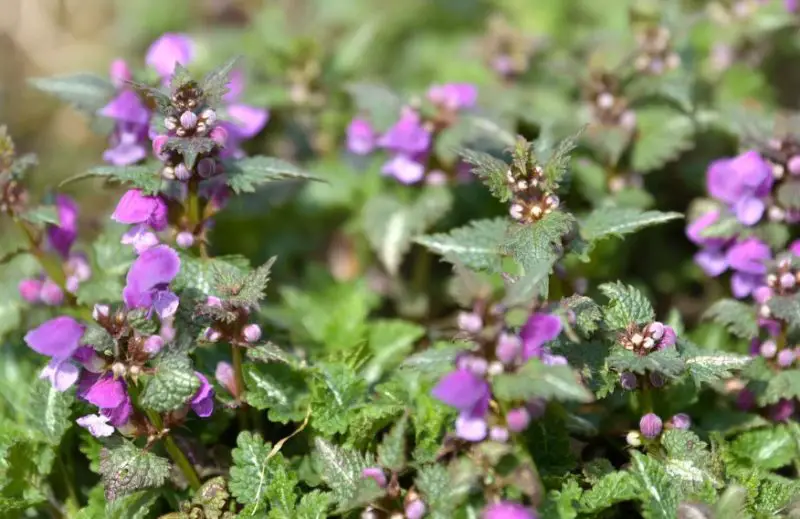
Since spotted deadnettle (Lamium maculatum) can become invasive in some areas, planting it should be done carefully and ideally after consulting your local extension office. On the other hand, it works wonderfully as a ground cover in regions that are heavily shaded when it is not an issue.
This plant has two decorative advantages: depending on the type, it produces eye-catching blossoms in a variety of colors, and its lovely silver leaves hold their color well into the post-flowering stage. It grows best in USDA zones 4 through 8, favoring acidic, well-drained soil and full shade over partial shade.
Sweet Woodruff
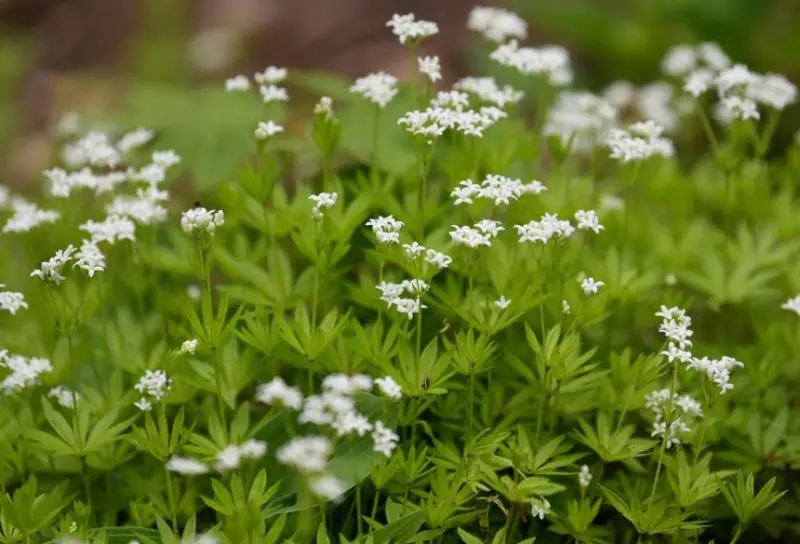
Sweet woodruff, or Galium odoratum, is a hardy ground cover that thrives in dry, shaded areas beneath big trees when other plants fail. Although it can grow invasively in wet soil, it is a hardy option for spaces beneath pine trees since it can flourish in acidic environments.
It has exquisite white flowers in the spring and can grow up to 12 inches tall and 18 inches wide. Sweet woodruff should be planted in dry soil with minimal irrigation to prevent its spread. Its fragrant leaves is a favorite for crafts and dehydrating. It grows best in USDA zones 4 through 8, with partial to complete shade and medium to wet, well-drained, loamy, acidic soil being its preferences.
Liverleaf
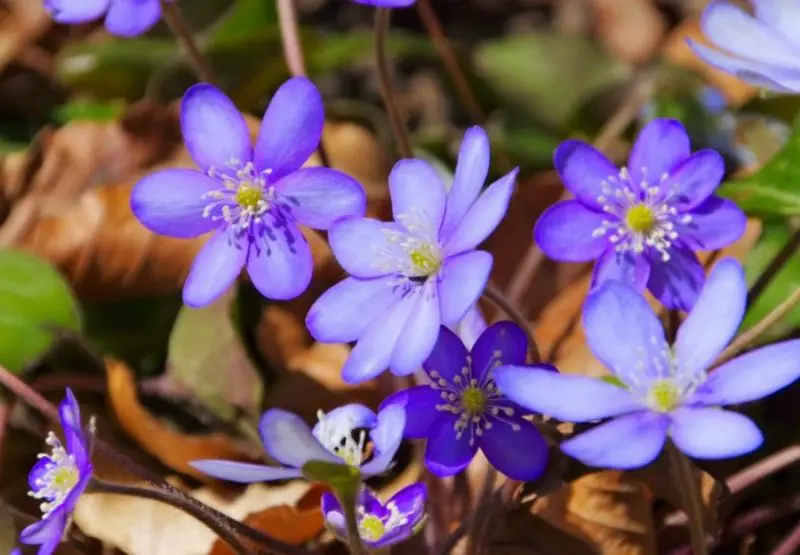
A native perennial wildflower of North America, liverleaf (Anemone americana, previously Hepatica americana) is prized for its evergreen foliage. Its waxy green leaves, which may turn brown in the winter and need to be trimmed up as needed, can grow up to 6 inches tall and 9 inches wide.
The plant gets its name from the summertime mottling of burgundy leaves that eventually turn completely burgundy. In USDA zones 3 through 8, liverleaf grows best In soil that is well-drained, humus-rich, and partially shaded.
Its white, pink, or lavender spring blossoms make it a great choice for tiny gardens, particularly when placed along walls that face north. It expands gently by reseeding without getting invasive.
Interrupted Fern

Interrupted fern (Osmunda claytoniana), a native North American plant, offers low-maintenance ground cover in shady areas. It spreads through rhizomes, which, while efficient for growth, can pose concerns for invasiveness in some contexts.
However, in its native habitats, it generally remains well-behaved. Known for its attractive foliage and distinctive name, interrupted fern thrives in USDA zones 3 to 8, preferring part shade to full shade and rich, moist, medium to wet, acidic soil conditions.
Lenten Rose
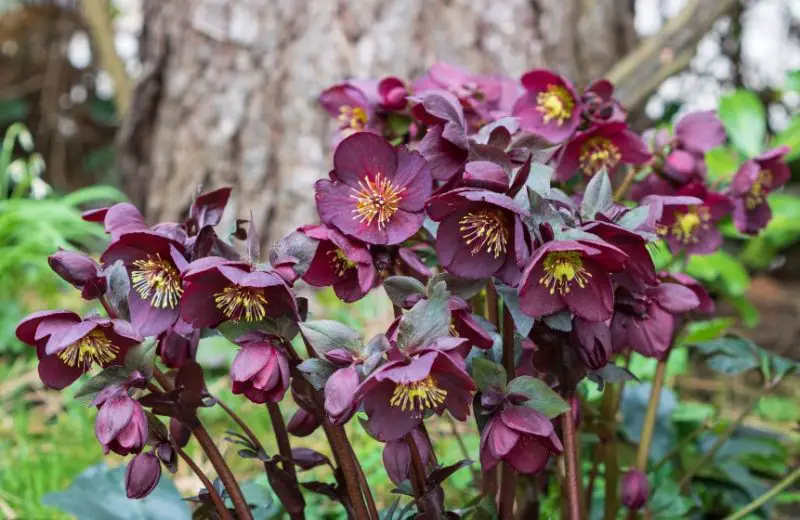
The Lenten rose is a member of the buttercup family, despite its name, and it blooms early in late winter with blossoms that pierce the ground. This hardy perennial ground cover grows because it is resistant to deer, which discourages grazing even when it may cause trampling. It is best planted in late spring or early fall, when it is protected from cold winter winds.
Spring division encourages longevity as ground cover lasts up to decades, and minimal maintenance consists of raking away winter-damaged leaves. Keep in mind that it is poisonous to animals. It grows best in USDA zones 4 through 8, and its colors range from white to pink to light rose-purple in partial to full shade. It needs wet, well-drained, loamy soil.
Ice Plant
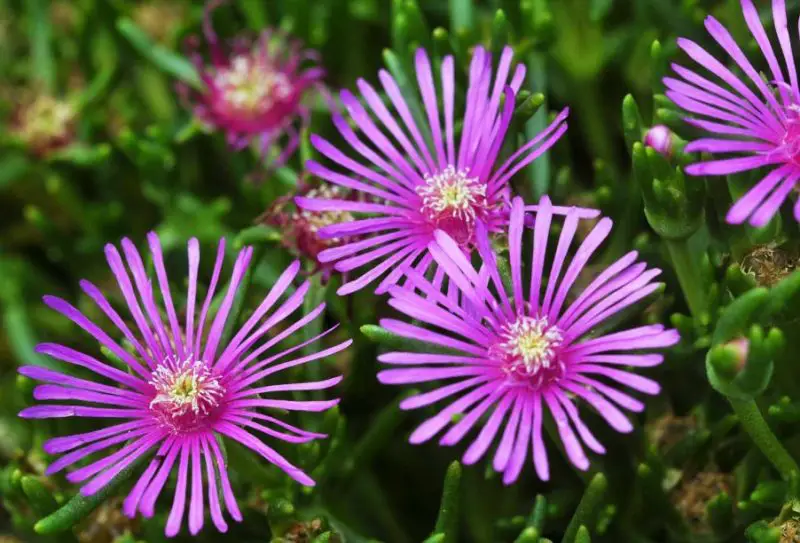
The perennial succulent ground cover known as “ice plant” is named for the way light gleams off its hairy growths, giving landscapes a sparkling appearance. It has fleshy leaves and bright blooms. It grows quickly and requires little care; it does best in full sun and sandy, well-drained soil.
Select climate-appropriate cultivars such as Delosperma floribundum ‘Starburst,’ which has pink flowers with white centers and is great for zones 6 to 8, or Delosperma brunnthaleri, which has yellow blooms and is perfect for zones 4 to 9. Ice plants are found in 11 different USDA zones, with colors ranging from pink, red, and purple to yellow and orange.
Candytuft
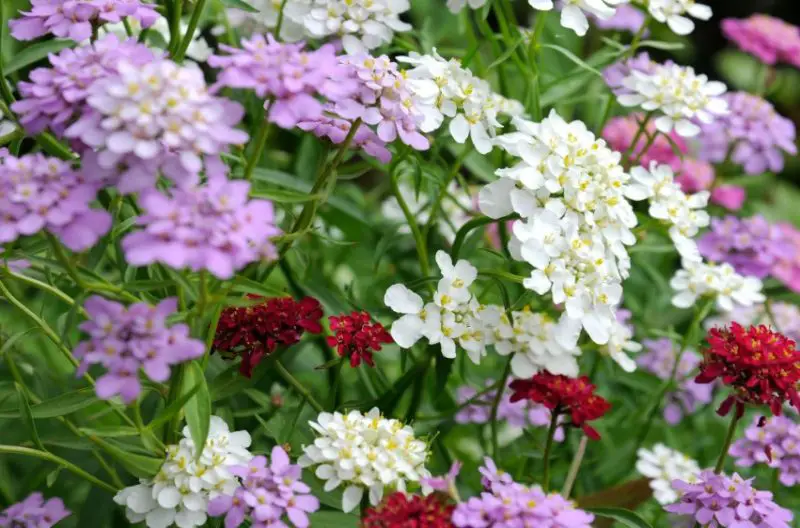
Perennial ground cover, candytuft grows in low clumps and flowers abundantly from spring through early summer. It retreats in the winter and then bounces back strongly. With gently scented blossoms, it’s perfect for moon gardens. Plant in full sun in colder climates in the spring, or in partial shade in warmer climates in the fall.
Pruning is occasionally necessary to keep this hardy, slow-growing plant in its compact form. Shades of white, pink, purple, and red are available. It grows well in USDA zones 3 through 9, preferring well-drained soil.
Common Periwinkle
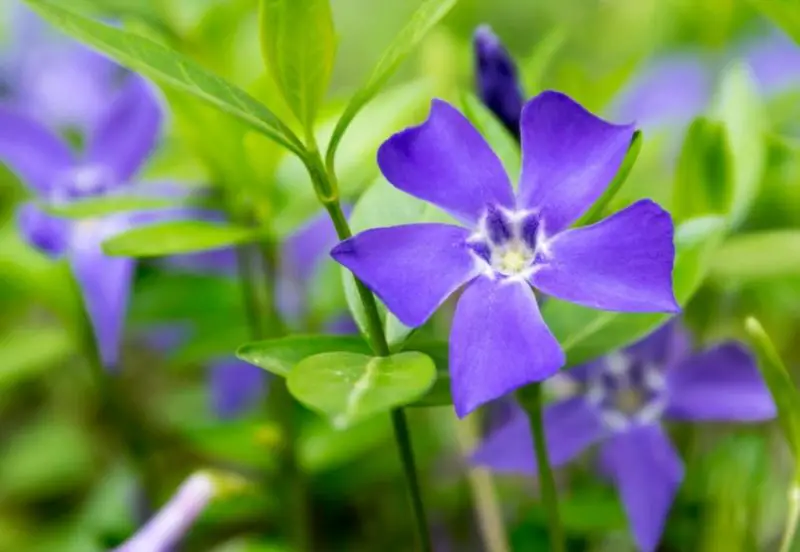
Vinca minor, often known as common periwinkle, is highly valued for its ability to withstand drought, repel pests, and grow in a variety of soil types at a reasonable cost. This evergreen vine quickly covers landscapes in pretty little blossoms. It is very good at controlling erosion because of its strong roots. But because of its rapid growth, it has a reputation for being invasive, and as it is harmful to pets, care should be taken.
It is blue, lavender, purple, and white in color, and it grows in USDA zones 4 through 9. It may grow in clay, sandy, or loamy soils, and it can be in full sun, medium shade, or shade.
Bugleweed
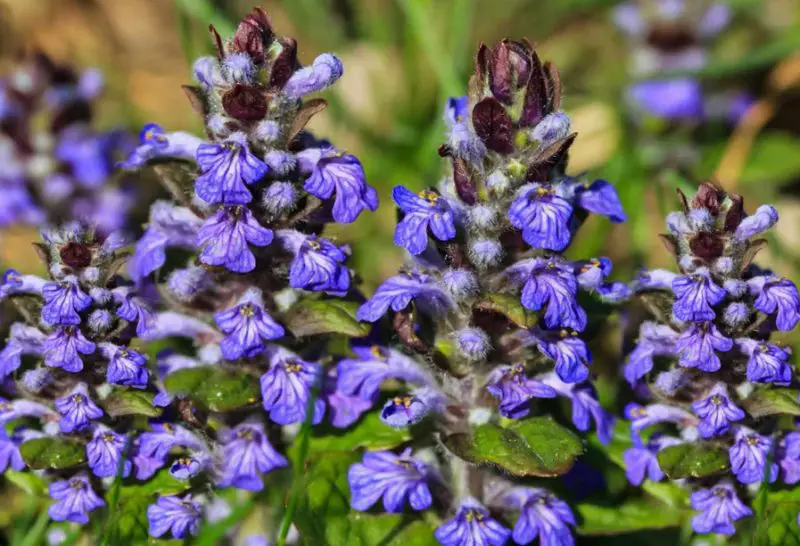
The scientific name for bugleweed is Ajuga reptans, and it has eye-catching flower spikes that are 6 to 9 inches tall and resistant to deer. Planting this vigorously spreading perennial ground cover in late spring or early summer will maximize its rapid growth.
Through stolons, it spreads quickly, creating dense mats that are perfect for controlling erosion and creating big, shaded areas.However, care should be taken around turfgrass to avoid harm. Its rapid growth can be managed by pruning after flowering or by cutting it at a high setting.
Growing in USDA zones 4 through 9, bugleweed looks best in soil that is medium-moisture and well-drained. It can withstand full sun to partial shade and displays blue and violet colors.
Chinese Lantern
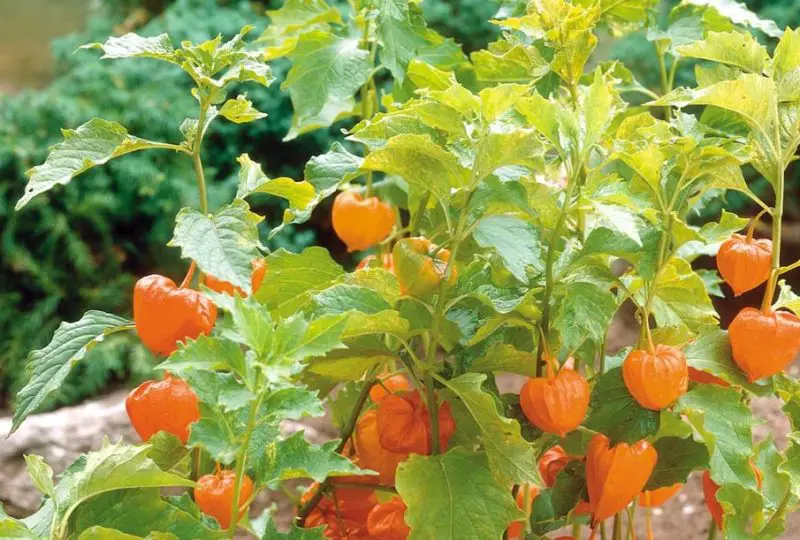
Chinese lanterns enhance the allure of fall to landscapes with their vivid orange-red seed pods that eventually turn into papery husks. It is preferred for large ground cover where it won’t infringe on nearby properties despite its invasive character. This perennial grows well when planted in late spring, but because of its aggressive spreading nature, it should not be placed in garden beds or next to turf grass.
It is toxic to people and animals, and it grows best in large, exposed regions in USDA zones 3 through 9. It needs well-drained, moist soil and can withstand full or partial sun exposure.
Creeping Liriope
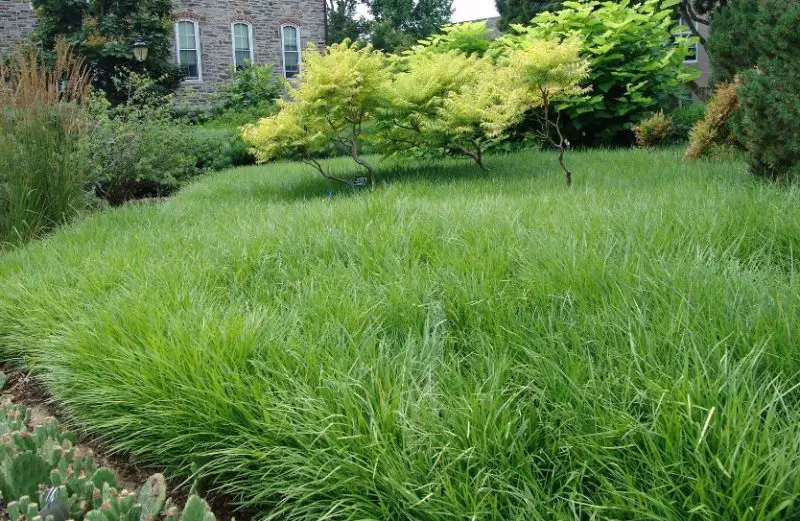
Scientifically named Liriope spicata, creeping liriope is a hardy, low-maintenance ground cover that is valued for its resilience to drought. It is a perennial herbaceous flowering plant in the asparagus family, despite seeming like grass. It is well-known for stopping soil erosion and has spikey flowers among grass-like leaves.
Plant it whenever you want it to grow quickly and spread, but be aware that in some parts of the United States, especially from Virginia to Mississippi, it may become invasive and aggressive. Showcasing lavender and white color variants, it thrives in USDA zones 4 through 10. It requires well-draining, sandy soil and adapts well to full or partial sun exposure.
Pachysandra
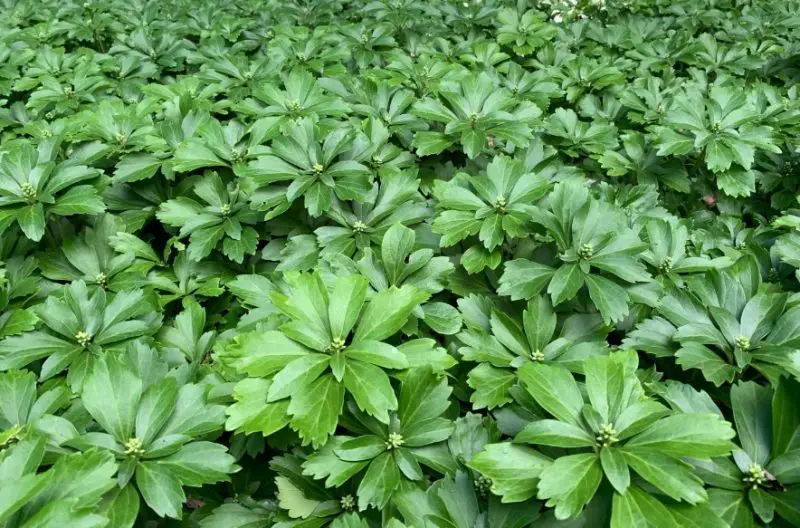
Pachysandra, or Pachysandra terminalis, is highly valued throughout the country for its hardiness. It can withstand harsh environments like shadow and dryness without experiencing winter dieback, and it keeps its leathery, dark green leaves all year long. It is a common and affordable ground cover that is resistant to deer and rabbits, making it perfect for large landscapes.
This quickly spreading plant uses underground runners to create dense mats. Its little white blossoms are modest for a flowering ground cover. It grows well in partial to full shade and is suitable for USDA zones 4 through 8. It also adapts well to any well-draining soil type.
English Ivy
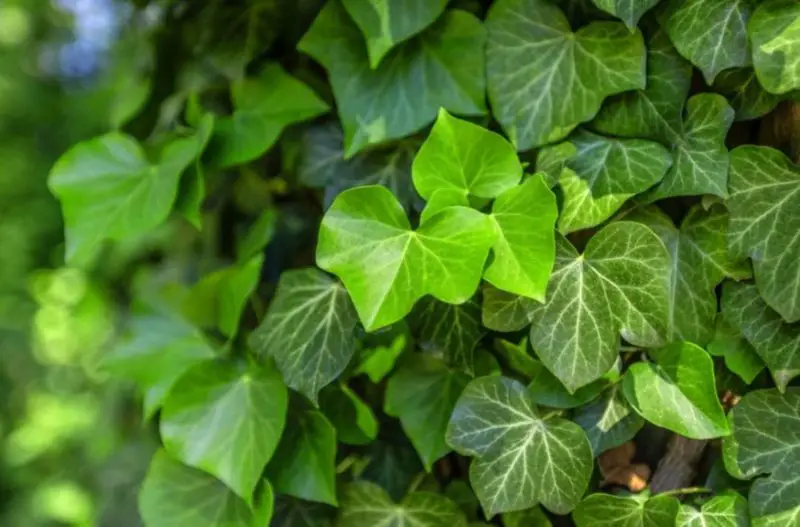
Hedera helix, sometimes known as English ivy, is an evergreen perennial ground cover noted for its capacity to scale walls and saunter across terrain. It is invasive and harmful to people and pets, but it nonetheless gives a yard something special. For a low-maintenance option, plant it in the spring; periodic trimming is required to maintain it within bounds.
If left unpruned, it can adhere to siding on houses or tree bark, making removal challenging and perhaps harming surfaces. It grows best in part to full shade and likes fertile, moist soil; USDA zones 4 through 13 are suitable.
Lamb’s Ear
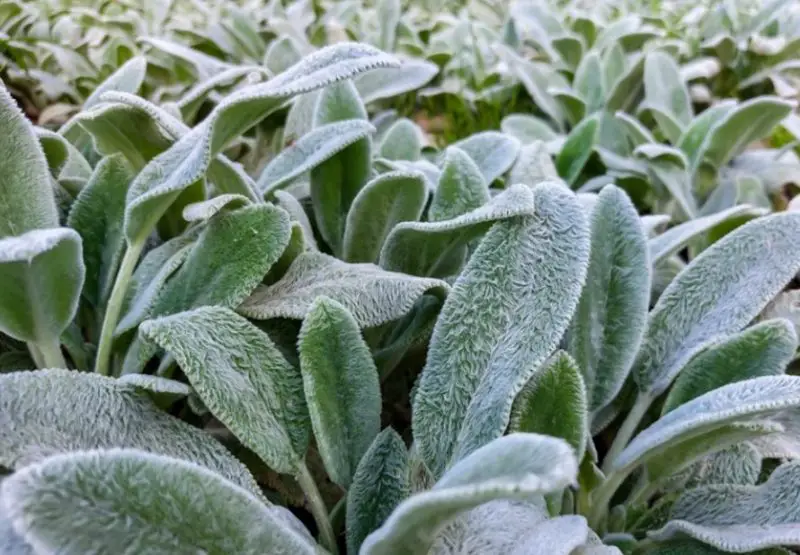
Because it can withstand dryness, lamb’s ear (Stachys byzantina) makes a silky, silvery carpet in sunny regions and is ideal for xeriscapes or rock gardens. Plant in April, this low-maintenance annual covers enormous areas by autumn and is resistant to deer and rabbits. When necessary, remove any rotten leaves that you find.
It takes a good shearing just before winter to let it regrow in the spring after dying back throughout the winter. A well-liked species that rarely flowers and grows only 4 to 6 inches tall is called “Silver Carpet.” It grows best in well-draining, uniformly damp to dry soil with full to partial sun exposure, and it is appropriate for USDA zones 4a through 9a.
Hosta
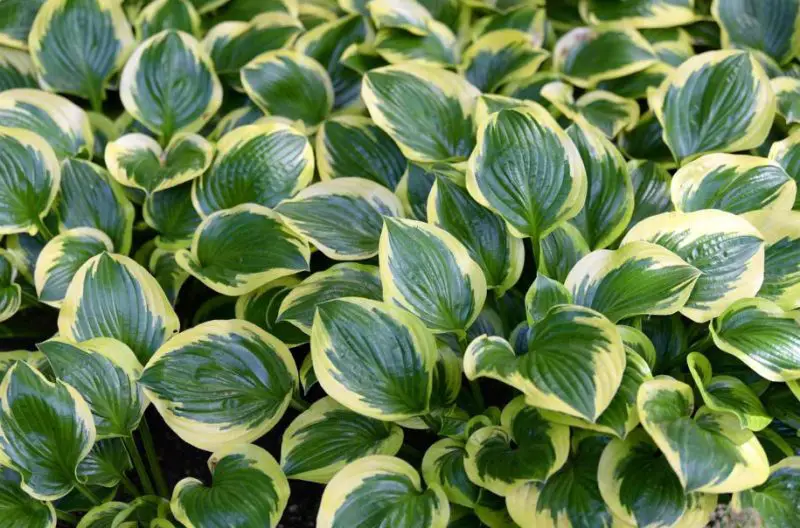
Hostas are hardy perennial ground coverings that spread via rhizomatous roots and thrive in a variety of light situations. They create well-groomed slopes and landscapes with no need for aesthetic pruning. Accessible in a multitude of sizes, ranging from tiny to enormous, such as ‘Blue Mouse Ears’ featuring little, blue-green foliage.
They grow best in USDA zones 3 through 9, preferring loamy, well-drained soil in shade or moderate light. They are not deer-resistant; however, they are toxic to animals. They have subtle blooms and colors, including pink, purple, and white.

